As an elementary teacher, managing small group instruction is no easy task. Elementary teachers usually have a class size of about 20-25 students with a variety of needs. Small group instruction is extremely important to give students individualized attention in order to meet the needs of students and for them to reach their maximum potential. So what do you do with the other students when you are meeting with a small group? What will the others do that is meaningful and productive without giving them “busy” work? For me, there was no other way than to implement, teach, and model Academic Learning Centers.
What are Academic Learning Centers?
Academic Learning Centers are a block of time during the school day, usually about 30- 45 minutes, which provides my students with meaningful academic choice while fostering independence. While my students work in their Academic Learning Center, I am able to pull small groups of students to work with students in reading groups or in an area of need by reteaching, reviewing, practicing, modeling, and offering challenges to support them.
Academic Learning Centers foster:
-
academic choice and exploration
-
both independence and collaboration with peers
-
strengthening and challenge of skills
-
practice of skills
Some examples of centers include:
-
Poetry
-
Writing
-
Word Study
-
Research/Computer
-
Library/Reading
-
Listening
-
Social Studies
-
Science/STEM
-
Math
How does this work in the classroom?
Students working in learning centers take responsibility for their learning by making an academic choice and record their learning in their learning center journal. There is a center task card in each center with a variety of academic choices. The best part of Academic Learning Centers is that the activities can be changed, differentiated, and modified to meet the needs of all learners and abilities in any grade level.
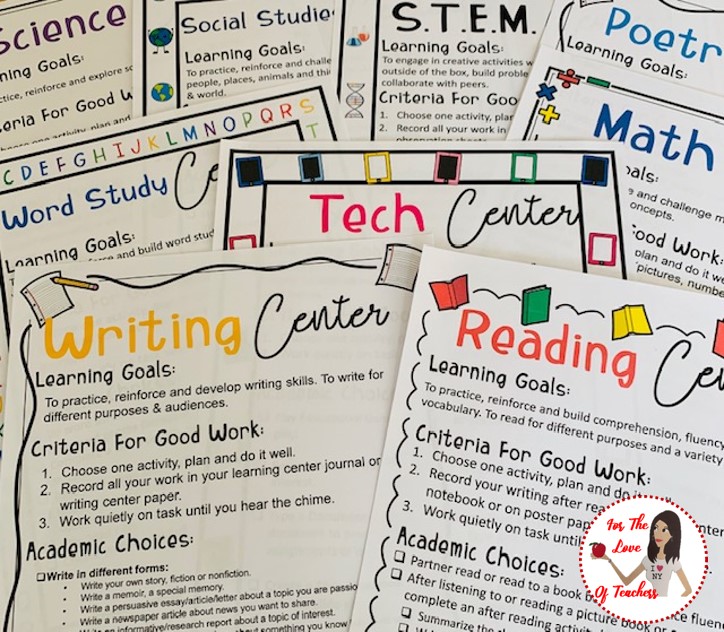
-
Display the task poster in each center (You can get my editable task posters here.)
-
Modify activities for grades and units of study
-
Provide a variety of materials in each center
What Materials Go In Each Learning Center?
Anything related to the subject area and units of study you are teaching in the classroom can go into your centers. Make the centers attractive and engaging for students. Of course, kindergarten centers would look very different from fifth learning grade centers, although sharing the same purpose of fostering independence and choice with a variety of learning activities.
For example, when I taught a 3rd-grade science unit on Rocks and Minerals, my students would act as practitioners and study as if they were geologists themselves. The center was stocked with all kinds of books on a variety of reading levels about rocks and minerals to read, learn, and record from. There are sets of rocks and minerals to observe with magnifying glasses. There are recording and observation sheets to draw, label, and record on. There are puzzles and games related to rock and minerals to extend and enrich learning. It was an engaging place for young geologists!
Here are some ideas for learning centers:
Writing
-
Books- books about writing, this could include picture books, one of my favorites, Eats, Shoots & Leaves: Why Commas Really Do Make a Difference or handbooks to support your writers. Remember picture books are not only for primary students. Upper Elementary students benefit from many concepts presented in picture books and there are many picture books geared toward upper grades.
-
Paper- fancy paper, lined paper, letter writing paper, construction paper, and drawing paper. I include a Make a Book station that includes all the papers necessary to make a book (table of contents, glossary, index, about the author page, etc.)
-
Tools- pens, pencils, colored pencils, highlighters, crayons, markers, etc.
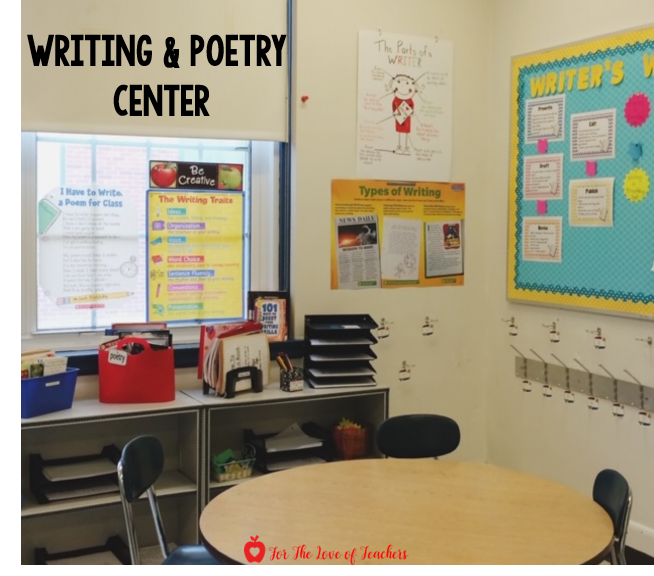
Poetry
-
Books from a variety of poets and styles- Where the Sidewalk Ends: Poems and Drawings by Shel Silverstein is a favorite!
-
Paper- encourages students to write their own poetry
-
Templates- haiku, sonnet, lyric, tanka, acrostic, cinquain, limerick, etc.
-
Tools- pens, pencils, colored pencils, highlighters, crayons, markers, etc.
Library/Reading
-
A large variety of books from fiction to non-fiction, picture books to big books to chapter books, in all genres
-
Include book projects and graphic organizers
-
Buddy Readers- stuffed animals for students to read with or to read aloud to practice fluency
Listening Center
-
Books on audio in different genres or series
-
Listening center reports or projects
Word Study
-
Word study games (My favorite…Hasbro Scrabble Crossword Game), Boggle, or any other word games
-
Word unscrambles
-
Word searches
-
Crosswords
-
Mad Libs
-
Word Sorts
-
Phonics activities
-
Flashcards
Math
-
Manipulatives- unifix cubes, snap cubes, pattern blocks, tiles, dominoes, base ten pieces, coins, geometric solids, clocks, fraction pieces, dice, counters, timers, etc.
-
Math games and activities for all areas and on a variety of levels –Math 24, Soduko, etc.
-
Include challenge activities for high math students
-
Flashcards (math facts in all operations, time, money, etc)
-
Math project ideas- Create your own math game
-
Sprints- for all operations and all topics in math.
-
Rubik’s Cube
-
Wipe off Graphic Organizers
Science/STEM
-
Books about units of studies or areas of interest on a variety of levels and interests (Read & Record)
-
Objects to observe (rocks & minerals, seashells, fossils, etc, (Observe & Record)
-
Recording & observation sheets
-
Magnifying glasses
-
STEM activities and projects, inventions
-
Models to build
-
Games and activities
-
Experiments
Social Studies
-
Books about units of study and on a variety of topics (people and places) and reading levels
-
Maps
-
Puzzles (world or continent puzzles, landmarks, etc)
-
Games and activities (ex. Landmark Bingo)
Organizing and Setting Up Learning Centers
-
Look at the physical space of the classroom. Setting up centers often works best along the perimeter of the classroom with nooks for students to work. Sometimes students would work at a table in front of the center shelves or on a carpet.
-
Display materials on shelves. Label shelves with center materials and activities.
-
Provide materials and resources related to center content and grade level.
-
Replenish center materials and activities as needed. Assign center helpers to keep track of and replenish materials.
-
Add different activities to keep it fresh and inviting.
-
Display Academic Learning Center Task Cards in each center.
-
Displays anchor charts and wall displays that reinforce the skills and strategies that you are teaching in each center.
-
Keep track of your centers by using a pocket chart. The pockets should say the center name, include a center picture, and the number of how many students could “fit” in that center. I had an index card with each student’s name on it and on the back of the card, I kept track of which centers they went into each day. I rotate where each student goes on a daily basis, but also allow students to return to the same center for a few days if they are working on a continuous project.
How Many Students Per Center?
Organizing how many students work in each center depends on your class size and the organization of centers. In my writing/poetry center, I only had a table that could fit four students, so I would assign 2 students to the writing center and 2 students to the poetry center. I had two student computers which allowed 2 students to work in that center at a time. I had a table that fit 6 students for the science and social studies center, so I assigned 3 students to science and 3 students to social studies. I had a carpet that was big enough for 4 students in the library center. I had a table large enough for 6 students to work in the math center, etc. You need to be able to fit all of your students into a center minus the students you will be meeting within a small group.
Do not assume that your students know how to work in centers independently or know how to make good choices for their learning. Model and teach the expectations and materials in each center. Here’s a modeling script that I use from my shop, Modeling Script-Academic Learning Centers, to introduce learning centers in my classroom. But just for reading this…it’s yours free! Yay! Who doesn’t love a freebie!!!
Add more scripts to your binder ring to model and teach all classroom routines and expectations.
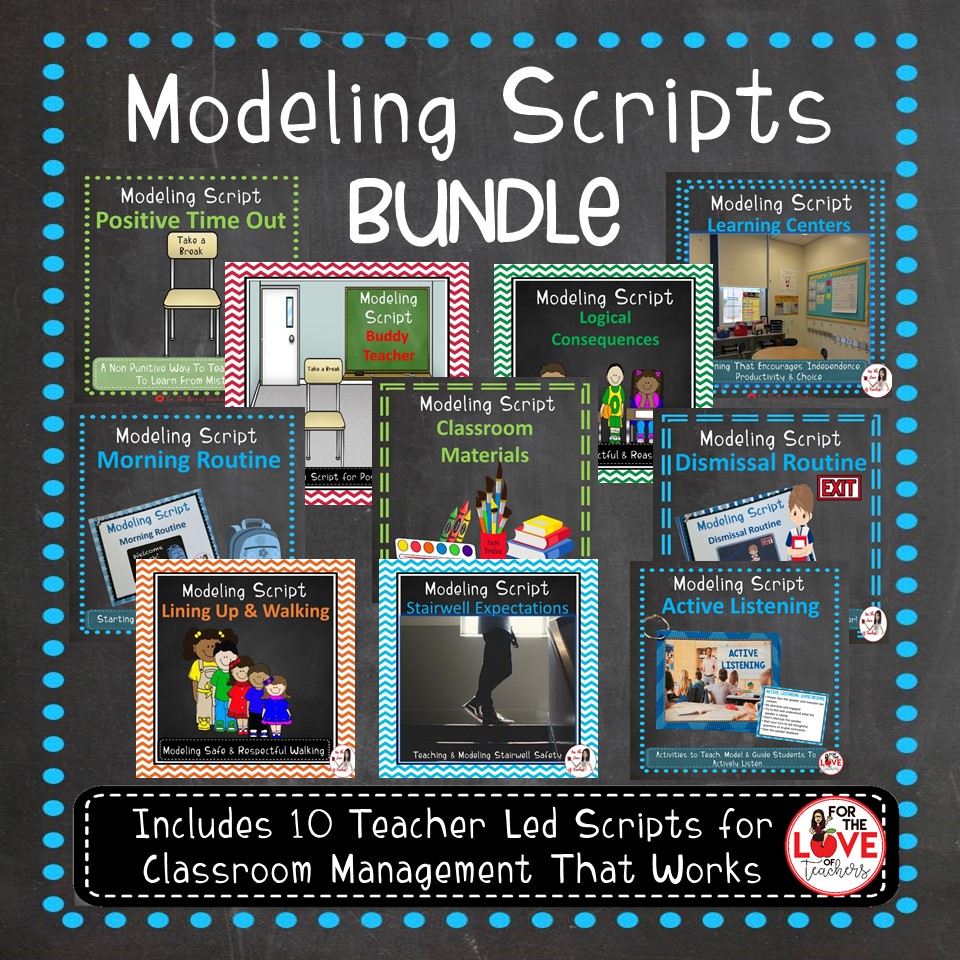
Investing the time to organize, manage, teach and model your Academic Learning Centers’ rules, expectations, and materials at the beginning of the year enables you to start off on the right foot with your small group instruction without interruptions. By teaching and modeling, early on helps with classroom management from the beginning. Your small group instruction will be effective and the other students are working on meaningful activities. My students get excited about their work in Academic Learning Centers so I allow a brief share of 2-3 students to share out what they worked on in their center afterward. Teach students that their center work may not be a one-and-done activity, but may need a few more days to complete.
How do you organize and manage learning centers in your classroom? Share in the comments.
Follow me to be notified when new resources are uploaded to the Shop and join the email list to receive the latest and greatest updates, posts, and some awesome freebies!!
If you like it, then pin it!
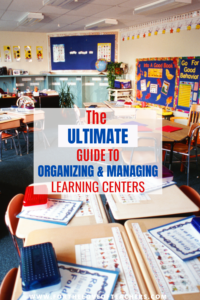

Christine Weis is a passionate educator, classroom management coach, wife, and mom of two busy boys. She enjoys teaching, writing, and creating resources for teachers.

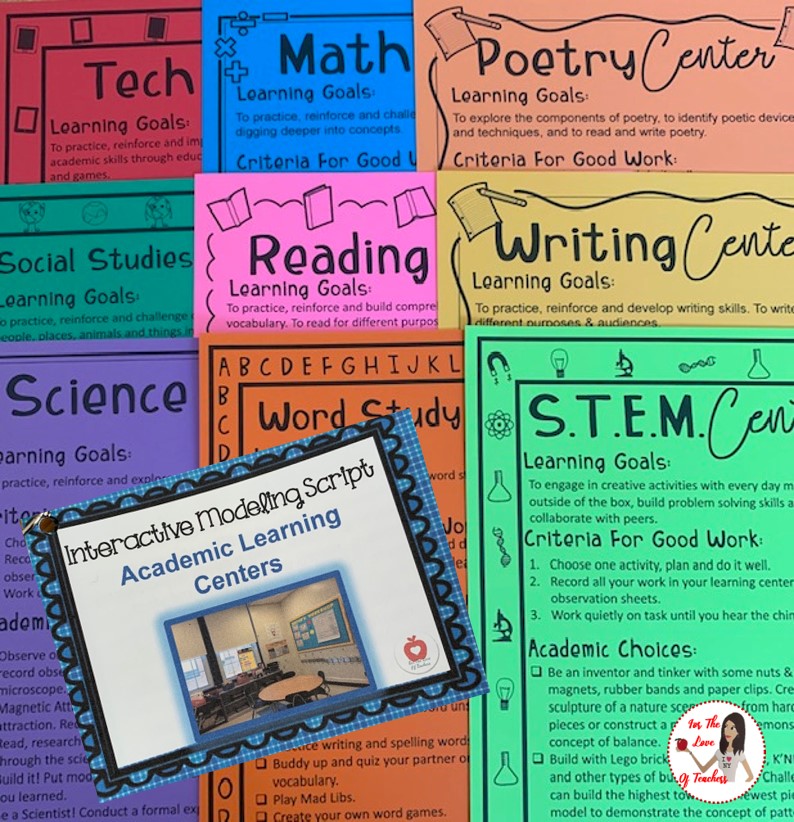





Is there a book you can recommend?
Hi. Great article. One question – do you do this in addition to core instruction or whole group? I have no idea how to find the time in the school day to do this. We have specific programs in our district that are supposed to be taught “with integrity”, which are whole-group based and have to be used. When do I find time in the day?!?
HI Jaye Anne,
This is such a great question. I do learning centers during my small group. So, let’s say I meet with two 15-minute groups, my other students are in learning centers. I rotate the learning centers daily. This does not interfere with whole-group or small-group instruction.
~Christine at For The Love of Teachers
What a wonderful way to learn! It seems like the students would get a lot more out these programs 💕 – Cori
It sure is!! Thanks for reading Cori!
Christine at For The Love of Teachers
Academic learning centers sound like a great idea. It gives kids a time to learn to be creative and learn to have fun while learning. Thanks for sharing.
Exactly! I would have loved some time in school just to have some independent learning time based on my interests. Thanks for reading!
Christine at For The Love of Teachers
Interesting read. We’re homeschooling at the moment and this has given me alot to think about in terms of our home classroom- thanks!
I teach undergrad college courses but I like this idea and am brainstorming some ways to implement a similar idea for college-level courses.
That’s a great idea, JEnn! I’d love to hear more about how you’d implement this at the college level. Thanks for reading!
Christine at For The Love of Teachers
I don’t think they had academic learning centers when I was in school, but having that block of time for students sounds very helpful and like a way to learn.
It sure is! It’s such a productive part of our day! Thanks for reading!
Christine at For The Love of Teachers
WooHoo! Such a great read! As a primary teacher, a classroom with centers is a must! I agree with ALL of it. I am so glad to hear you explain the importance of “Share”. It is a celebration of learning.
And thank you so much for the freebie script! Modeling is so very important. I can’t wait to dig into this one and learn new tricks.
Thanks Lori! I’m so glad you agree! “Share” is my favorite part after ANYTHING we do. Sharing and reflecting is so important.
Giving away freebies is so much FUN! I hope you could use the script with your kiddos! Thanks so much for reading!
Christine at For The Love of Teachers
I love that last bit! I can just imagine the chaos if you tell students ‘Go to a center” and don’t give them any further instructions! Not only should you model it, it’s also a good idea to have the students practice going to centers with you watching, before you start pulling out small groups. That way you know that they know what to do!
Yes, I agree! Guided practice for about a week is essential before I pull any groups. It’s smooth sailing from there! Thanks for reading!
Christine at For The Love of Teachers
Interesting concept! I think we had a similar thing in primary school where it was called something casual like “chill time” and you got to do something independent but still educational and fun!
Thanks Paige! “Chill Time” is more like our “quiet time” in our classroom but yes, a similar concept! Thanks for reading!
Christine at For The Love of Teachers
This sounds like a wonderful learning platform! I just love how there are so many options becoming available to students.
Thanks Danielle! I agree! It’s one of my favorite platforms where students could learn what they want and how they want. Thanks for reading!
Christine at For The Love of Teachers
This is awesome. I love learning and I know that everyone has their own distinct way to learn and absorb in the optimum way possible 🙂
Thanks Jojo! I agree! Academic Learning Centers allows students to learn what they want and how they want. Thanks for reading!
Christine at For The Love of Teachers
My son would love to be in that learning center 🙂 It looks really good
I hope he gets to work in many centers to pursue his interests! Thanks for reading!
Christine at For The Love of Teachers
Very helpful.
Thanks!
You are welcome Joyce! Thanks for reading!
Christine at For The Love of Teachers
This sounds like a great way for a child to pursue their own interests! Great concept.
xoxo Christie
‘http://icanstyleu.com/blog/
Yes…it is! I find that kids learn way more when they are pursuing their own topics of interest. Thanks for reading!
Christine at For The Love of Teachers
This platform seems like it would work really well for a variety of students. If they needed to challenged or if they needed more one on one time. Teachers are amazing at what they do and should always be appreciated for all their hard work!
Thanks Nina! What a great compliment to teachers everywhere!! I agree…it’s a effective platform for both practice and challenge! My students love it!!! Thanks for reading!
Christine at For The Love of Teachers
Thank you for the great ideas for Learning Centers. It’s hard to keep the rest of the class engaged in an activity so you can focus on a small group and these sound like great ways to help with that!
Thank you Amanda! I hope you could use some of these ideas in your classroom! Managing small groups is always a challenge. Thanks for reading!
Christine at For The Love of Teachers